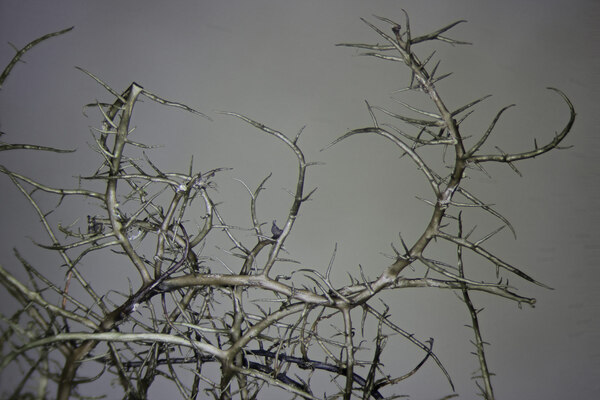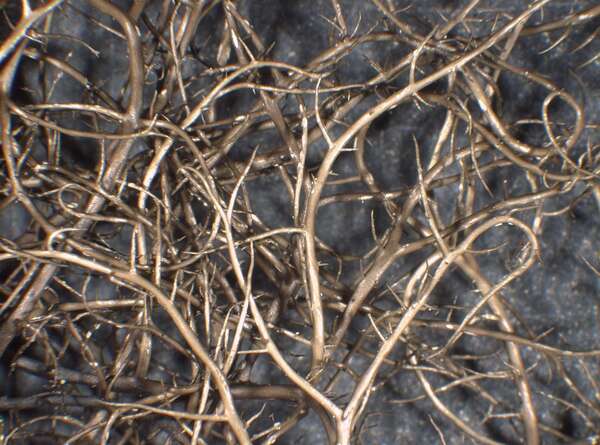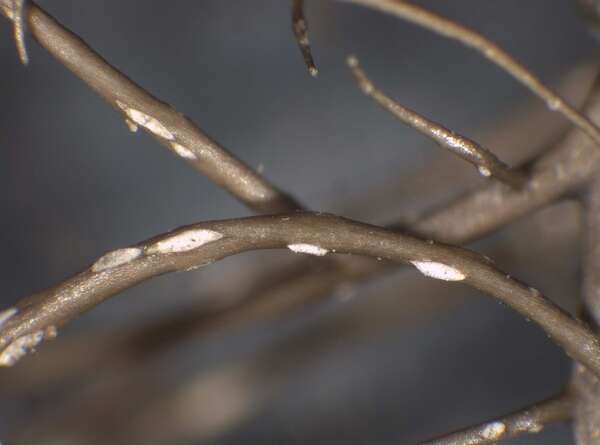Bryoria smithii (Du Rietz) Brodo & D. Hawksw.
Opera Bot., 42: 152, 1977. Basionym: Alectoria smithii Du Rietz - Ark. Bot., 20 A, 11: 15, 1926.
Synonyms: Alectoria berengeriana (A. Massal. ex Stizenb.) Gyeln. var. smithii (Du Rietz) Gyeln.
Description: Thallus fruticose, tufted or decumbent, 3-7(-12) cm long, bicolorous, the basal parts brownish black to black, the apical parts pale brown to brown, usually shiny, isotomic-dichotomously branching, with coarse and distinct, c. 1 mm thick, terete or basally slightly compressed, shallowly foveolate main branches, and short lateral spinules arising at right angles to main stem. Soralia fissural, concave to plane, white, with isidioid spinules and farinose soredia. Pseudocyphellae absent or inconspicuous; medulla white, compact. Apothecia unknown. Photobiont chlorococcoid. Spot tests: cortex and medulla K-, C-, KC-, P-. Chemistry: without lichen substances.
Growth form: Fruticose filamentous
Substrata: bark and rocks
Photobiont: green algae other than Trentepohlia
Reproductive strategy: mainly asexual, by soredia, or soredia-like structures (e.g. blastidia)
Most common in areas with a humid-warm climate (e.g. most of Tyrrenian Italy)
Commonnes-rarity: (info)
Alpine belt: absent
Subalpine belt: rare
Montane belt: very rare
Dry submediterranean belt: absent
Humid submediterranean belt: absent
Padanian area: absent
pH of the substrata:
1 2 3 4 5
Solar irradiation:
1 2 3 4 5
Aridity:
1 2 3 4 5
Eutrophication:
1 2 3 4 5
Poleotolerance:
0 1 2 3
Altitudinal distribution:
1 2 3 4 5 6
Rarity
absent
extremely rare
very rare
rare
rather rare
rather common
common
very common
extremely common
Loading data...
Occurrence data
Predictive map
Growth form: Fruticose filamentous
Substrata: bark and rocks
Photobiont: green algae other than Trentepohlia
Reproductive strategy: mainly asexual, by soredia, or soredia-like structures (e.g. blastidia)
Most common in areas with a humid-warm climate (e.g. most of Tyrrenian Italy)
Commonnes-rarity: (info)
Alpine belt: absent
Subalpine belt: rare
Montane belt: very rare
Dry submediterranean belt: absent
Humid submediterranean belt: absent
Padanian area: absent
pH of the substrata:
| 1 | 2 | 3 | 4 | 5 |
Solar irradiation:
| 1 | 2 | 3 | 4 | 5 |
Aridity:
| 1 | 2 | 3 | 4 | 5 |
Eutrophication:
| 1 | 2 | 3 | 4 | 5 |
Poleotolerance:
| 0 | 1 | 2 | 3 |
Altitudinal distribution:
| 1 | 2 | 3 | 4 | 5 | 6 |
Rarity
absent
extremely rare
very rare
rare
rather rare
rather common
common
very common
extremely common
Loading data...
Occurrence data
Predictive map









